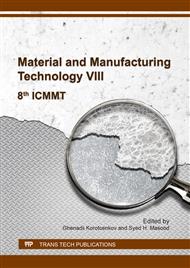p.172
p.177
p.182
p.187
p.196
p.201
p.207
p.215
p.221
Influence of Indium and Antimony Additions on Mechanical Properties and Microstructure of Sn-3.0Ag-0.5Cu Lead Free Solder Alloys
Abstract:
In this research, we investigated the influence of indium and antimony additions on the microstructure, mechanical and thermal properties of Sn-3.0Ag-0.5Cu lead free solder alloys. The results revealed that the addition of 0.5 wt.%InSb into SAC305 solder alloys resulted to a reduced melting temperature by 3.8 °C and IMCs phases formed new Ag3(Sn,In) and SnSb in the Sn-rich matrix with a decreased grain size of 28%. These phases improved the mechanical properties of solder alloys. In addition, the mechanical properties of SAC305 solder alloys increased by adding 0.5 wt.%InSb, resulting in an increase of ultimate tensile strength of 24%, but the percent elongation decreased to 45.8%. Furthermore, the Vickers microhardness slightly increased of the SAC305 solder alloys.
Info:
Periodical:
Pages:
196-200
Citation:
Online since:
October 2017
Price:
Сopyright:
© 2017 Trans Tech Publications Ltd. All Rights Reserved
Share:
Citation:


